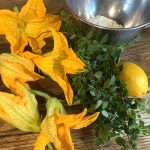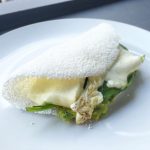I was in the front garden and noticed the marigolds I planted in my cement pots had severe damage. At a closer glance, I saw pill bugs everywhere. You may know them as roly-poly bugs or potato bugs from when you were a kid.
I found it strange because marigolds are considered an insect repellent and planted in vegetable gardens to detract pests. The pill bug is not a picky eater apparently and the pungent flavor of this beautiful annual doesn’t detract this garden pest. Upon some research, I learned if nourishment is scarce, pill bugs will eat their own excrement. So, a marigold must be like a plate of eggplant parmesan to me.
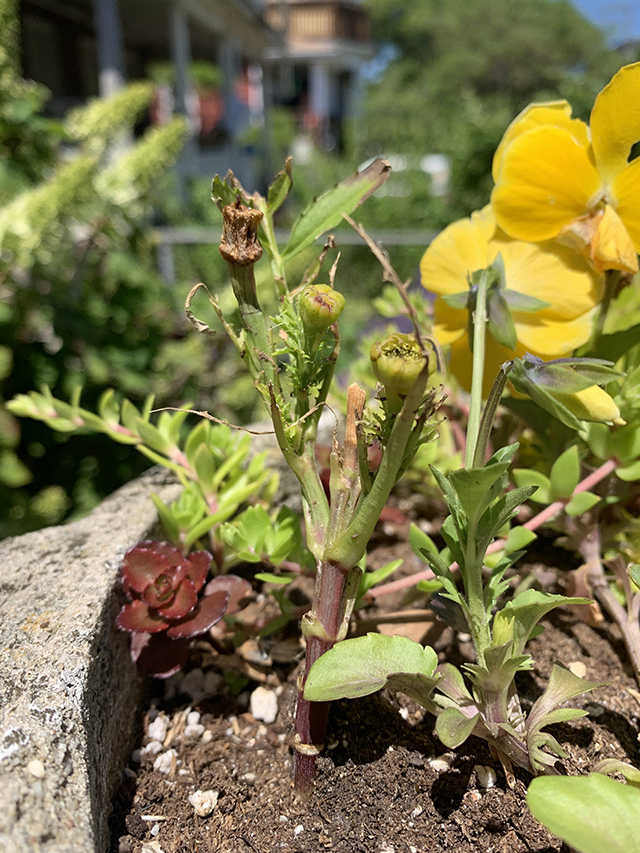
Damaged marigold
As I’m loudly complaining about the decimation of my flowers, my neighbor Eric walks by. He says “Do you know those bugs are related to horseshoe crabs?” “Wow, so interesting” I thought. These are the kinds of things about gardening that really fascinated me. I had to look this up.
Eric was right, Pill bugs are in the arthropod phylum (which includes spiders, insects, and crabs). They are crustaceans, descended from trilobites, and directly related to horseshoe crabs. Like their ocean counterparts, pill bugs have blue blood and they molt. These arthropods need to live in a moist environment. And most interesting of all– they breathe through gill-like lungs on the outside of their body. If they’re outside of a moist environment (in a planter, under stones, a piece of wood on the forest floor, etc.) they will quickly suffocate.*
In other garden news…
My hanging baskets I wrote about a few weeks back are doing pretty well. The petunias have grown since. The sedum and stone crop has been a little more challenging to keep alive. Since I placed those plants throughout the metal basket frame, I need to water them with a spray bottle. Despite them being drought tolerant, it’s been a little tedious. Some areas have died back but not all. I know this would be a lot of work and I’m still committed!
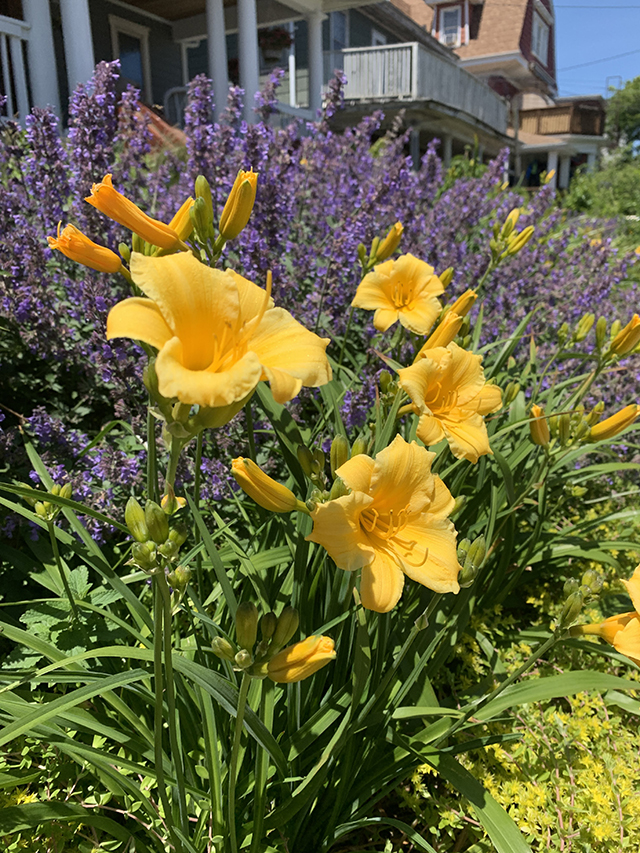
It’s lily season. My stella de oro daylilies are in bloom and just in time for some needed color to contrast the purple Walker’s Low overgrowthing [sic] in the garden. Remember – deadhead daylilies when the flower shrivels back- usually within one day of bloom, as their name reminds us. By deadheading throughout the season you will ensure the flowers are constant.
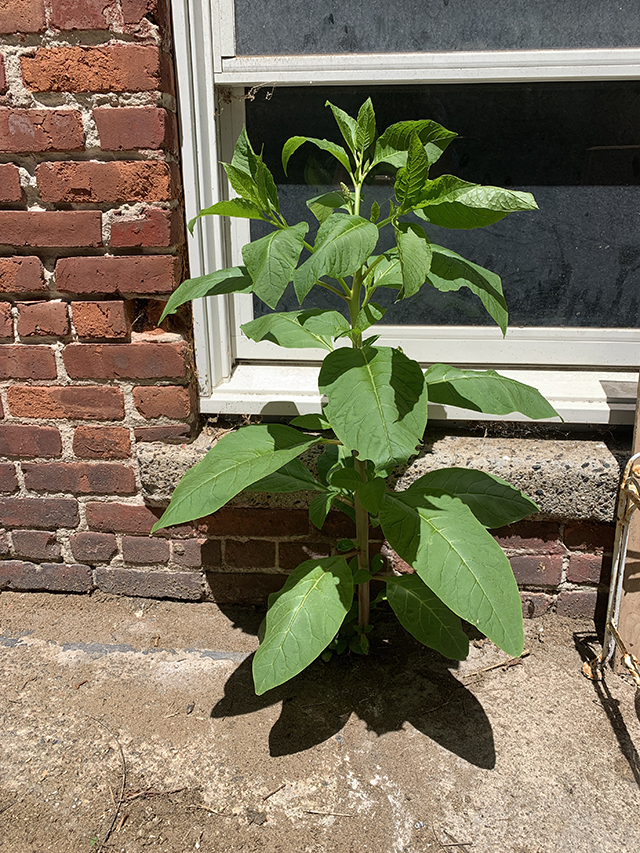
Lastly, I found what I believe is pokeweed, poking out of a crack in the cement in my backyard. It looks cool, very “urban garden”. I want to keep it but I wasn’t sure if it would damage the foundation of the house. I took to the Google-verse and read on Wikipedia that it has a long tap root. It’s not a weed, it’s a perennial plant that can grow up to 8ft tall. Probably not good for the foundation, ugh. More concerning, all parts of pokeweed are toxic to humans and pets. But then I read that its berries are food for many birds and small animals. I think the cons are weighing out the pros and I’ll have to remove it. ‘Tis the life of a gardener.
For more on gardening in Rockaway, follow me on IG: @theglorifiedtomato
Previously published in rockawave.com

Last week, I felt uneasy about my column on chives, given all that’s going on. I needed some time to process. I ended up rewriting this column for this week three times. It just doesn’t feel okay for me to write about gardening or cooking right now.
Our whole nation is in crisis. The killing of George Floyd on May 25th and the conversation about the resulting protests for justice and equality has entered every household in America, including mine. These hard discussions often take place around the dinner table. So while off “tomato topic” I want to share my feelings here.
I feel a heaviness. I feel angry. I feel confused, anxious and guilty. I feel an urgency to educate myself on the Black Lives Matter movement.
My brother-in-law James Walsh wrote something that resonated with me and I couldn’t say it any better than he did:
“Thank God for young people, man. They’re the ones who are going to keep us moving forward when so many things conspire to set us back.
In the middle of a pandemic they’re taking to the streets, risking their health and their lives to demand justice. To be the voice for the voiceless and the power for the powerless.
There is so much to worry about in the current state of our country, but when I see them, I see hope. Progress is made when society reaches a tipping point on important issues, and when your baseline is one of equality (LBGTQ, racial, economic, etc), you’re already so far ahead in terms of being the driving force for change.
They [the kids] already see the nonsense that divides this country. They do not need to be taught about the greed of the financial industry, the threat of the military-industrial complex, or the danger of police brutality. Those are a given, and someday they will be in the halls of power, taking these lessons to create a more just society.”
When I was a kid, I knew nothing of protesting or injustice in my life. I just read about the wrongs of our country in social studies class. And who knows if what I was reading was even true.
My feelings of hope were ignited when I saw the young kids protesting two week ago at the peaceful vigil for Geoge Floyd at Beach 95th street and the boardwalk. I was inspired by their outspokenness, courage and knowledge.
Over the weekend I went to the paddle out for George Floyd organized by Black Surfing Rockaway (@black_surfing_rockaway). It was held at 9am in the morning at beach 109th street. I rode my bike on the boardwalk and realized immediately the crowds of surfers and people on bikes in black were all headed in the same direction. The assembly on the beach was larger than I expected. It’s hard to judge a group of this size, but it had to be more than 1,000 people. The feeling of community unification and hope was present on the sand and in the sun, as words were spoken by the Black Surfing Rockaway organization before the paddle out.
It felt amazing to stand with friends, neighbors and other like minded Rockaway folks in solidarity as the surfers took to the water with flowers in hand. Prayer like chants and claps came and went like the waves in the ocean. I was with my friend Erin Silver, owner of Zingara Vintage. We started to cry. It was that moving. Change can start small, locally in our community. Be the change! No justice, no peace!
Previously published in rockawave.com
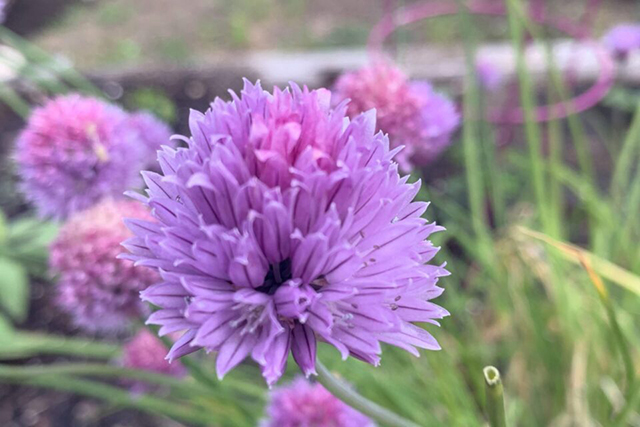
I’ve been spending some time this week in the Beach 91st Street Community Garden. I only planted my vegetables two weeks ago because it’s been unseasonably cold. Despite the late start, things are looking good.
This year, I have two cherry and two beefsteak tomato plants. The cherry tomatoes do very well in the garden for some reason. I have two cubanelle pepper plants, squash, kale, cilantro, sage, basil, and chives. I think I over-planted my plot. I couldn’t help myself!
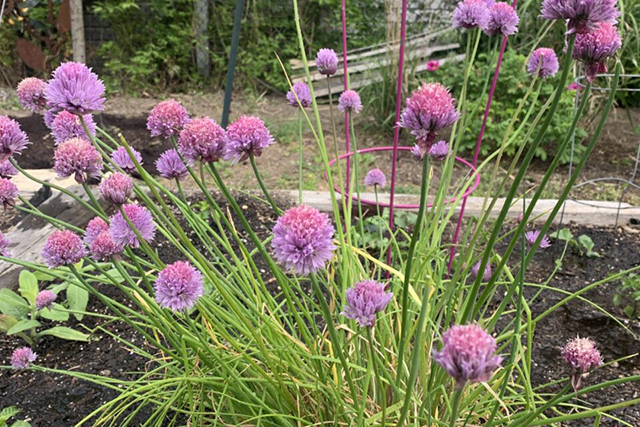
Flowers and the scapes of this easy-to-grown herb are edible. Divide the plants every three to four years in the spring for optimal productivity. It’s drought tolerant and thrives in full sun.
Last year I bought the chive plant because it was in full bloom and looked beautiful. Its flowers are round, puffy and purple. I learned only this week from a friend in the community garden that the flowers are edible!
Chives are perennials, relatives to onions, garlic, shallots, leeks, and scallions. The scapes are delicious in salads; to season meat or fish; in an omelet; on homemade french fries, you name it. The flavor is onion-like but less intense.
Another advantage gardeners appreciate when planting chives is its insect repellent quality. It will deter garden pests from eating your vegetables.
Bees also benefit from this herb. Chives are a great pollinator and if you have a plant in your garden, you’ll see bees dancing around it.
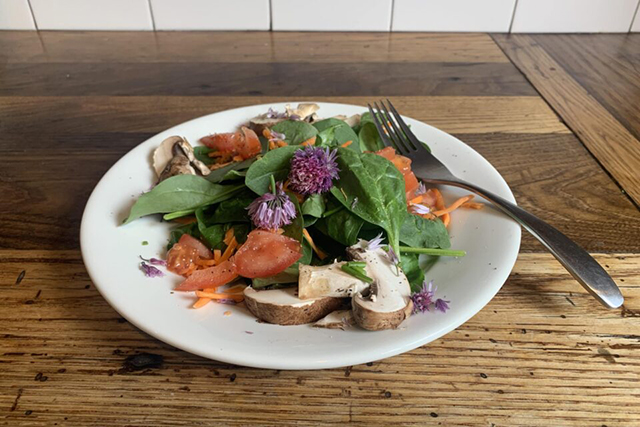
Add some “wow factor” into your meal by using the flowers of the chive plant in a salad
Between its beauty, its culinary properties, its benefits to bees, and the environment, chives are a win-win for your garden.
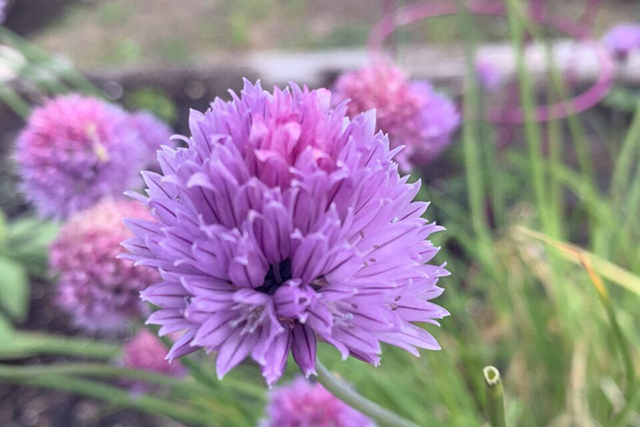
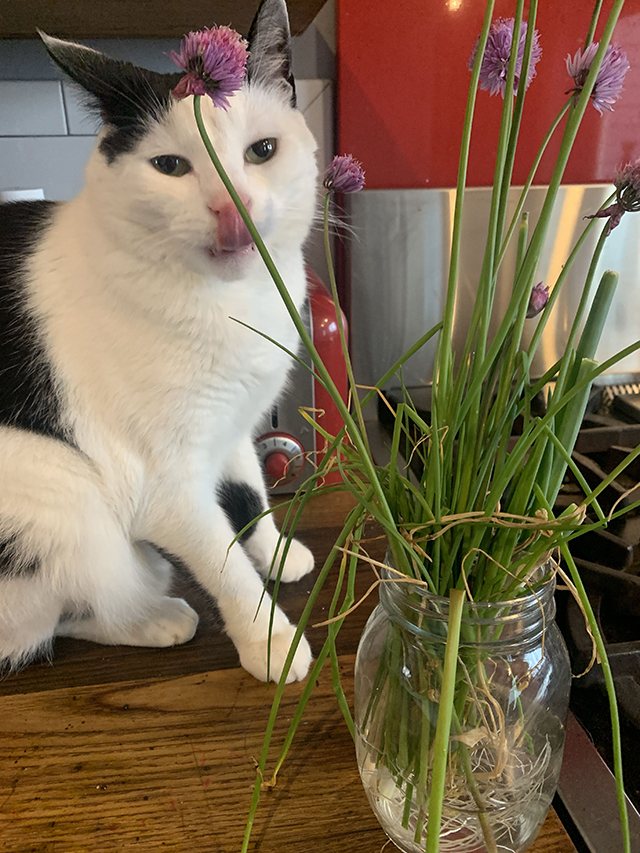
Bring some extra chives in from the garden for their ornamental appeal. Also, your cat may enjoy investigating their pungent aroma.
For more on gardening in Rockaway, follow me on IG: @theglorifiedtomato
Previously published in rockawave.com
by Paula D.
on June 23, 2020 7:29 am in DIY
I have a vague memory of watching the Oprah Winfrey show when I was a kid. The episode was about beautiful wrap-around porches in the south. Since then, I’ve been obsessed with porches and porch style. When it comes to Rockaway porch style, Aunt Brenda is the master. Before I lived in Rockaway, I’d come down to the beach to see Matt. We’d pass Aunt B’s on the way to the water and I’d always admire her house. Brenda’s porch then and now is worthy of a spread in Better Homes and Gardens. She has outdoor wicker furniture, comfortable, colorful cushions, and a swing! The essentials are intermixed with large potted planters and beachy decor. The focal point of it all, are her cascading, lush, hanging baskets.
When we were looking for a house 6 years ago and saw a shabby old Rockaway home right by the beach with a big old porch, I was sold.. despite the shabby and old. I’ve accumulated a nice set of wicker furniture and I have an outdoor rug. My mother-in-law handmade us lovely seat cushions. My potted plants are set around the porch to bring the garden in.
And of course, I have hanging baskets, beautiful ones Aunt Brenda gave me actually. I haven’t mastered the talent of basket planting though. Every year, I’ve had trouble. Whether it be salt-tolerant issues, choosing the wrong plants or forgetting to water them. This year, I’m determined to have full, flowery baskets. I enlisted the help from master basket-planter, Aunt Brenda.
“You need a thrill, a fill, and a spill. That’s the trick to the design of the basket.” Brenda tells me. She explains the “thrill” is a taller plant placed in the center, – the focal point. She suggests a spiky palm or salvia. The fill is a transitional plant with a shorter height. Something like a marigold or a vinca. The “spill” is what cascades. Aunt B said she’s had success with wave petunias, silver helichrysum petiolare, asparagus fern, and sweet potato vine, which come in purple or bright green.
Once you have the correct plants selected, you use a coco mate liner to hide the plastic container. This also helps retain water. And Brenda stressed, “You must water your baskets everyday.” I think this is where I’ve fallen short in past years. Baskets try out quickly from the sun and interestingly, I learned from our conversation, the wind too.

Petunias have some tolerance to salt
I’ve been watching this new reality show on Netflix, The Big Flower Fight. It’s a little cheesy but I’ve been inspired by it. Most of the episodes involve the teams creating live flower sculptures from metal and chicken wire. Think Edward Scissorhands meets Martha Stewart.
With Aunt B’s guidance and my new inspiration, I started designing my basket. I had already bought big petunias before consulting Aunt Brenda. Those will form the basis of my baskets, accented by mosses and succulents. Those bring a warm element to the design and I’m hoping it will bring more layers of cascade.

Here I’m using a skewer to push through sedum and cocoa mat
Follow me on Instagram @theglorifiedtomato, to see how my hanging baskets fair over the summer. I’ll document the progress, for better or for worse!




















